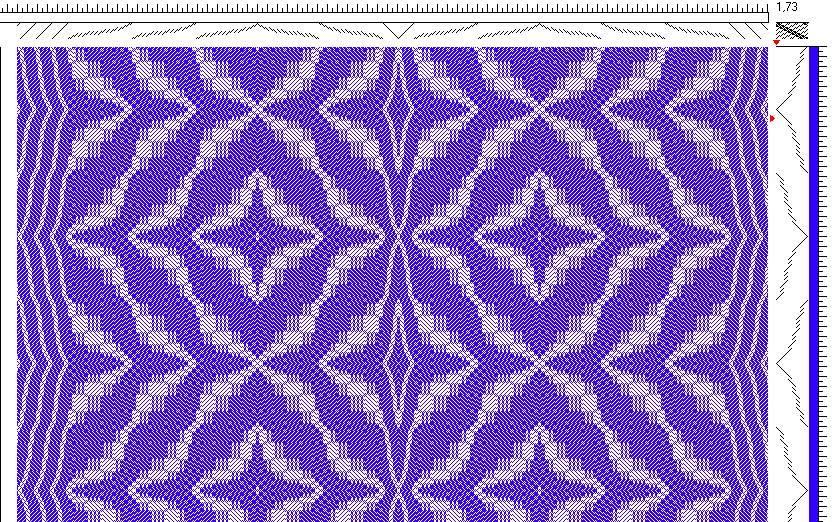Continuing to explore the weave structure I went back to something simpler. I call this one 'twinkle star' and it seems in keeping with the season.
I still have no idea what to call this weave structure. Maybe it isn't important that it has a 'name'? We 'name' things as a kind of short hand. Instead of saying 'twill blocks shifted a half block at a time', which is cumbersome, it needs a 'name' that conveys what it is. After mulling it over for a year or so, I've kind of settled on shifted twill blocks. Advancing twill blocks didn't seem quite...right.
Have I ever seen this particular weave structure before? Can't say that I have. That doesn't mean that it hasn't ever been done before, though, just that I've not seen it documented.
Is this weave structure 'mine'? Nope. No one 'owns' a threading sequence.
It may not have been recorded in a resource I've seen before, but that means nothing. Humans have been weaving, in one form or another, for millennia. I'm quite sure I'm not the first weaver to stumble across it.
How did it come to me? When I look back and connect the dots, I had been exploring similar things for 20 or so years, dabbling a bit, then setting them aside as deadlines roared and I had no time to explore.
The first time I did something similar to this was with Summer and Winter, when I used double two tie unit weave to make more detailed designs in that weave structure. The units were stepped in just the same way as the twill blocks - shifted by half a unit. This allowed me to create designs that had curves that flowed, that were less 'block-y'.
How did I come up with doing that? I'd been weaving Bronson Lace in pick up, based on a workshop I took with Mary Bentley doing pick up Summer and Winter, and realized I could do other unit weaves in the same pick up technique. As part of my exploration of doing Bronson Lace in pick up, it occured to me that I could weave half units for details.
Prior to that, I'd taken a workshop with Peter Collingwood who explained his shaft switching technique and it was a revelation that just because a yarn was on a particular shaft, that didn't mean it was permanently controlled by that shaft. By extension, I saw that unit weaves could be 'shifted' in their threading/treadling. The options were more limited, but there was less 'fiddling'.
The challenge is to remember that in the treadling each block is controlled by four different treadles. When I design the treadling, therefore, I can't just get the software to generate the treadling. Or at least I don't see how I could do that. I could try customizing block substitution treadles, but so far, I haven't bothered. Because I am still learning how the lines 'work'. How they flow. How far I can push them, here and there, and create a motif I'm happy to weave.
But none of this would be possible without the work done by other weavers before me.
I first heard "we stand on the shoulders of giants" from Judith MacKenzie. Since then I've seen it elsewhere. Every time I hear/read it, I think about my ancestors, the weavers who worked with threads, explored the possibilities, laid the groundwork for me, my generation, to carry on.
And I think about all the teachers I've had, some now sadly gone on to the great loom room in the sky, and I nod and send a thought of gratitude to them.
This weave structure is treadle hungry, so easiest done with a computer assisted loom. But if anyone is interested in exploring it, I documented how it worked in Stories from the Matrix. I even provided a skeleton tie up so that others don't have to work it out for themselves. If you play around with it, I hope you'll share. I'd love to see what others do with the idea.




No comments:
Post a Comment